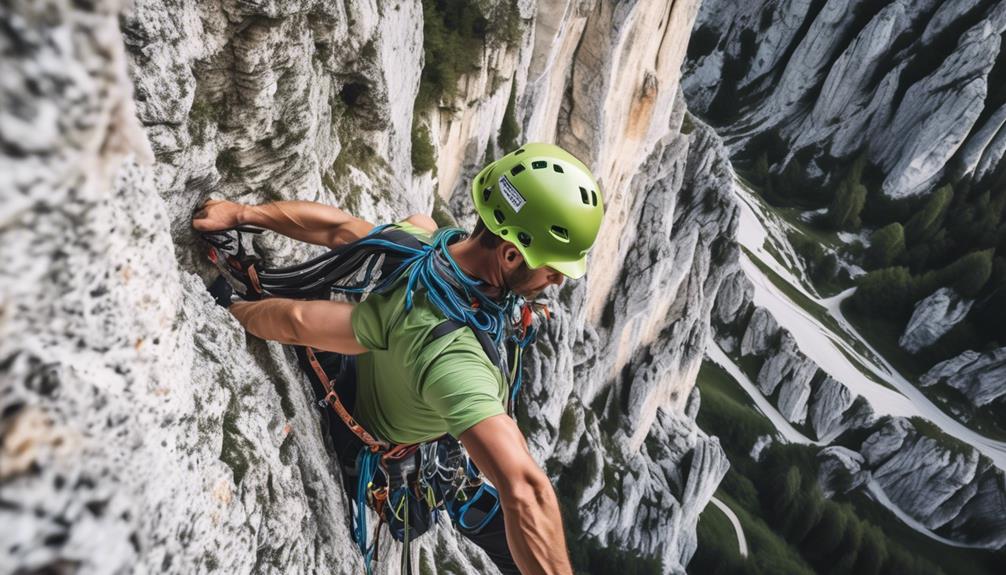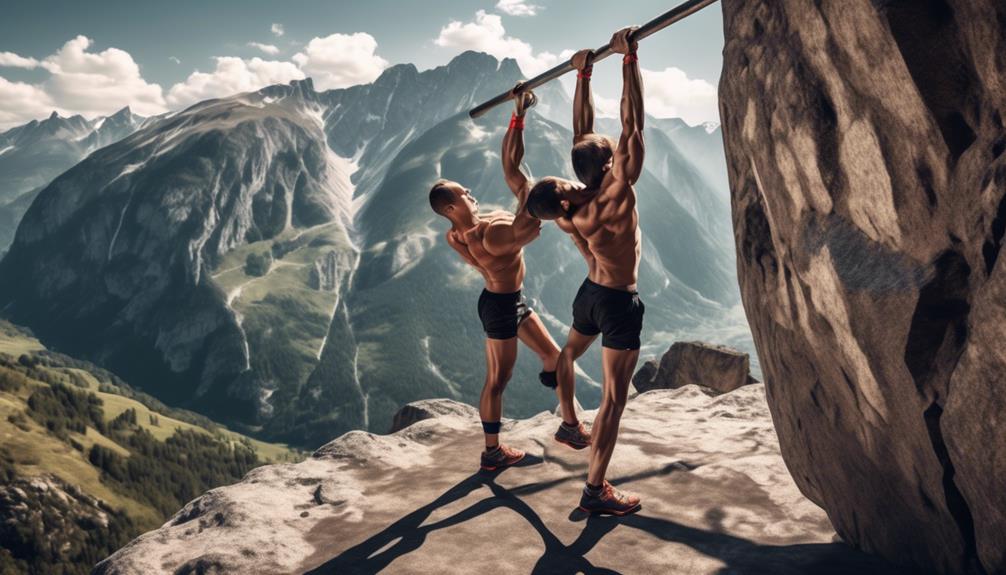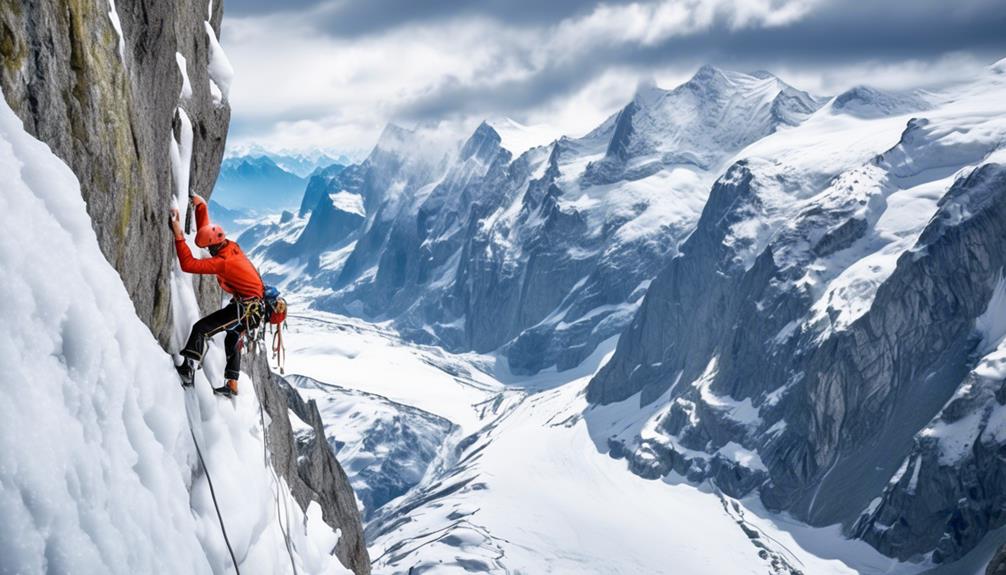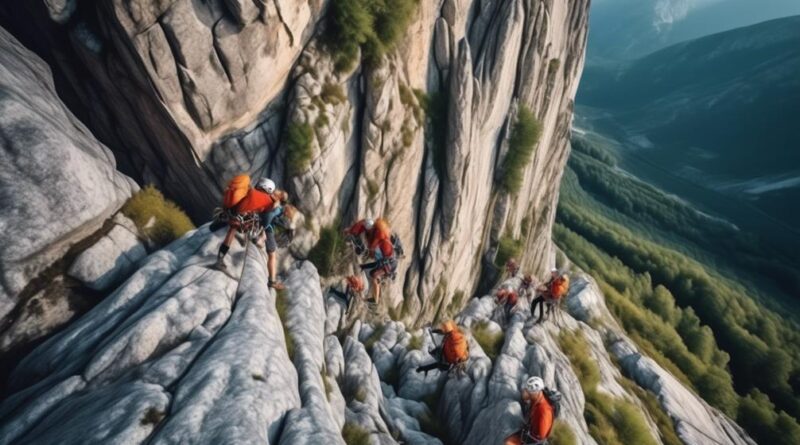14 Tips for Rock Climbing Adventures in Europe
If you've never explored the diverse rock climbing opportunities in Europe, you may be surprised to learn that the continent offers an array of stunning and challenging climbing locations. From the rugged peaks of the Alps to the breathtaking cliffs along the Mediterranean coast, there's something for every level of climber.
But before you pack your gear and set off on your European climbing adventure, there are some essential tips and considerations that can make your experience safer, more enjoyable, and ultimately more rewarding.
So, let's dive into the details and ensure you're well-prepared for your upcoming rock climbing expedition in Europe.
Best Rock Climbing Destinations
Embarking on a rock climbing adventure in Europe will lead you to some of the best destinations for challenging and exhilarating climbs. Whether you're a beginner or an experienced climber, Europe offers a variety of terrains and rock formations that cater to every skill level. When it comes to rock climbing techniques, Europe provides a diverse range of experiences, from traditional climbing in the Swiss Alps to deep water soloing in the turquoise waters of Mallorca. Each destination offers its own unique set of challenges and rewards, making it an ideal location for climbers seeking to expand their skills and push their limits.
One of the most appealing aspects of rock climbing in Europe is the breathtaking views that await you at the summit. Imagine scaling the limestone cliffs of Kalymnos in Greece, with the deep blue Aegean Sea stretching out below you, or conquering the iconic peaks of the Dolomites in Italy, surrounded by stunning alpine scenery. These awe-inspiring vistas not only make the climbs themselves more rewarding but also offer a sense of connection to the natural world that's truly unparalleled.
As you plan your rock climbing adventure in Europe, consider the specific rock climbing techniques required for each destination and take the time to appreciate the breathtaking views that will accompany you on your journey. Whether you seek the thrill of vertical ascents or the tranquility of remote crags, Europe has something to offer every rock climber.
Essential Gear for Climbing
When preparing for your rock climbing adventure in Europe, it's essential to equip yourself with the proper gear to ensure safety and success on the challenging terrains and rock formations.
Proper gear maintenance and equipment care are crucial for ensuring the longevity and reliability of your climbing equipment. Before embarking on your journey, take the time to inspect all your gear, including ropes, harnesses, carabiners, and climbing shoes, to ensure they're in good condition. Regularly clean and lubricate any moving parts, and store your gear in a dry, cool place to prevent damage from moisture and extreme temperatures.
In addition to maintaining your gear, focus on developing your climbing techniques and skills. Practice efficient footwork, body positioning, and breathing techniques to enhance your climbing abilities. Consider taking a refresher course or hiring a guide to improve your technical skills and learn advanced climbing techniques that will be beneficial for navigating the diverse and challenging rock formations in Europe.
Moreover, investing time in strength and endurance training will significantly improve your climbing performance and reduce the risk of injuries.
Safety Precautions and Tips

Inspecting and maintaining your climbing gear is crucial for ensuring your safety as you embark on your rock climbing adventure in Europe. Prioritize risk management by thoroughly checking your ropes, harnesses, carabiners, and other equipment before each climb. Make it a habit to inspect for any signs of wear and tear, and always double-check that your gear is properly secured. Additionally, familiarize yourself with emergency procedures and ensure you have the necessary knowledge and equipment for self-rescue and assisting others in case of an accident.
When climbing, pay close attention to your technique and body positioning. Proper climbing technique not only enhances your performance but also reduces the risk of accidents. Keep your body close to the wall to maintain balance and conserve energy. Use your legs to push yourself up rather than relying solely on your arms, and practice controlled movements to prevent sudden slips or falls.
Furthermore, be mindful of your body positioning, especially on challenging routes. Understanding how to distribute your weight and maintain a stable center of gravity can significantly impact your safety while climbing.
Choosing the Right Guided Tour
To ensure a memorable and safe rock climbing experience in Europe, selecting the right guided tour is essential for maximizing your adventure. When choosing a guided tour for your rock climbing adventure, there are a few key factors to consider:
- Tour Operator Selection: It's crucial to research and select a reputable tour operator with a strong track record in organizing rock climbing expeditions. Look for operators with experienced guides who are certified in rock climbing and wilderness first aid. Reading reviews and seeking recommendations from fellow climbers can also help you identify trustworthy tour operators.
- Itinerary Customization: Opt for a guided tour that offers some level of itinerary customization. This allows you to tailor the experience to your skill level, whether you're a beginner looking for introductory climbs or an experienced climber seeking more challenging routes. Customizable itineraries also ensure that you make the most of your time by focusing on the specific regions and climbing spots that interest you the most.
- Group Size and Dynamics: Consider the group size and dynamics offered by different guided tours. Some climbers prefer smaller groups for a more personalized experience, while others enjoy the camaraderie of larger groups. Choose a tour that aligns with your preferences and comfort level.
- Safety Measures and Equipment: Prioritize guided tours that prioritize safety and provide high-quality climbing equipment. Inquire about their safety protocols, emergency preparedness, and the condition of their gear to ensure a secure and enjoyable climbing experience.
Physical Training and Preparation

Once you've secured the right guided tour for your rock climbing adventure in Europe, it's time to focus on your physical training and preparation for the challenging climbs that lie ahead.
Strength training is crucial for rock climbing. Incorporate exercises like pull-ups, deadlifts, and core workouts to build the necessary upper body and core strength. Additionally, don't overlook lower body strength as it plays a vital role in pushing yourself up the rock face.
Flexibility exercises are equally important. Include yoga or stretching routines in your training to improve your range of motion, which can help you maneuver through difficult climbing positions with greater ease.
Nutrition plays a significant role in your rock climbing performance. Ensure your diet is rich in lean proteins, complex carbohydrates, and healthy fats to fuel your body for the demanding climbs. Stay hydrated and consider packing high-energy snacks for the climbs.
Mental preparation is often underestimated but is crucial for success in rock climbing. Practice visualization techniques to familiarize yourself with the climbs and mentally prepare for the challenges you may encounter.
Climbing Etiquette and Rules
Before embarking on your rock climbing adventure in Europe, familiarize yourself with the climbing etiquette and rules to ensure a safe and enjoyable experience for yourself and others.
When venturing into the European rock climbing scene, it's important to adhere to climbing ethics and minimize your environmental impact. This involves respecting the natural surroundings, staying on designated paths, and properly disposing of waste. Additionally, be mindful of the local flora and fauna, refraining from disturbing wildlife and avoiding damage to vegetation.
Interacting with local communities is an integral part of the rock climbing experience in Europe. It's essential to show respect for local traditions and customs. This includes being mindful of cultural practices and demonstrating courtesy towards locals. Respecting the areas surrounding climbing sites and keeping noise levels to a minimum also contribute to positive interactions with the communities in these regions.
To ensure a harmonious climbing experience, always adhere to established climbing rules and guidelines. This includes obtaining permits where necessary, following designated climbing routes, and respecting any closures or restrictions. Furthermore, maintaining open communication with other climbers and practicing good sportsmanship fosters a welcoming and cooperative climbing environment for all.
Weather Considerations and Seasons

Considering the weather and seasons is crucial for planning a successful rock climbing trip in Europe. Seasonal changes significantly impact climbing conditions, so it's essential to time your trip accordingly. In general, the best time for rock climbing in Europe is during the spring and fall.
During these seasons, the weather is relatively mild, and the conditions are ideal for climbing. Spring offers longer daylight hours and blooming landscapes, while fall provides cooler temperatures and stunning foliage.
In spring, you can expect more stable weather and less extreme temperatures, making it perfect for climbing in various European destinations. As the snow melts, it's also an excellent time for alpine climbing in places like the Swiss Alps and the Dolomites.
Fall is also a fantastic time for rock climbing, especially in southern Europe, where the heat of summer starts to dissipate, and the crisp air makes for excellent friction on the rocks.
However, it's important to research the specific climate of the region you plan to visit, as some areas in Europe may have different optimal climbing seasons. For instance, Mediterranean climates can be too hot for climbing in the summer, while northern regions might be inaccessible in the winter due to snow and ice.
Cultural Experiences and Local Cuisine
Immerse yourself in the rich cultural experiences and savor the diverse local cuisines while exploring the rock climbing destinations across Europe. As you embark on your rock climbing adventures, take the time to indulge in the cultural offerings and culinary delights that each destination has to offer.
Here are some ways to enhance your journey:
- Local Festivals: Seek out local festivals happening near your climbing destination. These events offer a window into the traditions and customs of the region, from music and dance to food and crafts.
- Traditional Crafts: Explore the traditional crafts of the area, such as pottery, weaving, or woodcarving. Engaging with local artisans can provide insight into the cultural heritage and craftsmanship of the region.
- Culinary Delights: Treat your taste buds to the flavors of the region. Sample traditional dishes and delicacies at local eateries, and don't hesitate to ask for recommendations from residents.
- Wine Tasting: Many rock climbing regions in Europe are renowned for their vineyards. Take a break from climbing to enjoy a wine tasting experience, where you can learn about the local wine production and savor the distinct flavors of the region.
Frequently Asked Questions
What Are the Visa Requirements for Rock Climbing in European Countries?
You'll need to check the visa requirements for each European country you plan to visit. Additionally, make sure you have travel insurance that covers rock climbing, and consider supporting local conservation efforts. Gear rental options are available.
Are There Any Specific Cultural Customs or Etiquette to Be Aware of While Rock Climbing in Europe?
When rock climbing in Europe, be aware of cultural norms and safety regulations. Respect local customs, communicate clearly with others, and follow established climbing guidelines. Stay informed about specific etiquette and safety practices in each region.
What Are the Options for Emergency Medical Services or Rescue Teams in Popular Rock Climbing Destinations in Europe?
In popular rock climbing destinations in Europe, emergency response times can vary, so it's important to have insurance coverage and be familiar with local medical facilities and rescue teams. Always prioritize safety.
Are There Any Specific Environmental Conservation Efforts or Regulations That Rock Climbers Should Be Aware of in European Countries?
In Europe, be aware of environmental regulations, conservation efforts, and access restrictions while rock climbing. Respect climbing ethics and follow local rules to preserve the natural beauty and ensure a sustainable future for climbing.
What Are the Options for Renting Climbing Gear in Popular Rock Climbing Destinations in Europe?
When rock climbing in Europe, you can rent climbing gear at popular destinations like Chamonix in France, Arco in Italy, and El Chorro in Spain. Rental options vary, so research ahead for the best gear.
Conclusion
Now that you have the essential tips for rock climbing adventures in Europe, it's time to start planning your trip.
Remember to pack the necessary gear, stay safe, and respect the local climbing rules and etiquette.
Whether you're a beginner or experienced climber, Europe offers a diverse range of climbing destinations and cultural experiences.
So, get ready to explore stunning landscapes, challenge yourself on the rocks, and indulge in delicious local cuisine.
Happy climbing!
